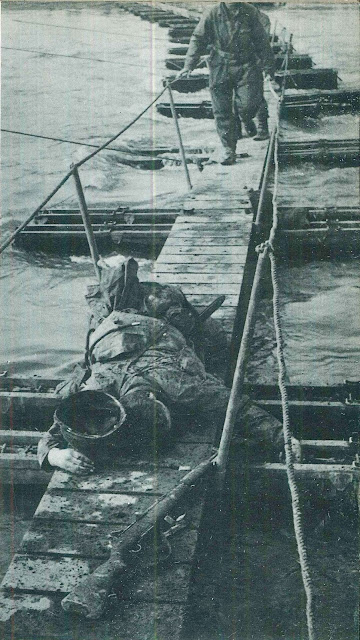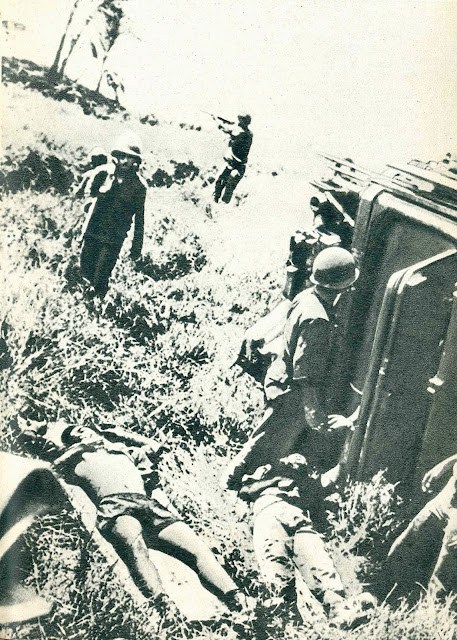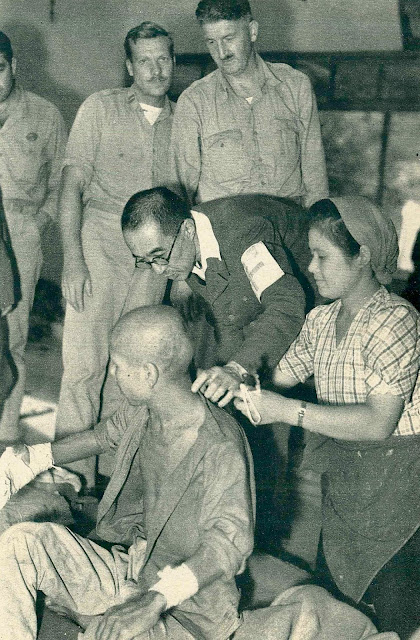U.S. soldiers advance past the scattered bodies of Japanese soldiers who were swept up and killed in the Paco district on Feb. 12, 1945, during the Battle of Manila in the Pacific War. American troops continued to fight from house to house and street to street to clean up the Japanese forces in Manila. There were many enemy strongholds in the city of Manila, but by February 22, the Japanese were driven back into the small walled city.
American troops returned to the Philippines on January 9, 1945, and landed on the shores of Lingayen Gulf. They invaded about 100 miles to the south to liberate Manila. The Japanese forces split up and also fought a long war in the forests and jungles of Luzon. To defend the capital city, Manila, to the death, the Japanese dispersed about 17,000 Japanese soldiers to the north, central and south of Manila. They defended the high walled citadel and fortified city. The buildings were blocked to make the advance more difficult. They built staggered walls through corridors, leaving gaps for grenades.
American troops occupied Manila as they surrounded it. Manila was fortified and the trapped citizens of Manila were in chaos. at 6:35 p.m. on February 3, American troops rolled into Santo Tomas, Manila, to prepare for the liberation of Manila. The Japanese, however, began their systematic destruction of the city later that day. Incendiary bombs went all around the districts north of the Pasig River, setting fire to buildings and blowing them up. They blew up all the bridges over the Pasig River that divided the city. After destroying the northern districts, they crossed the river and retreated to central Manila. The American troops crossed the Pasig River and began a bloody urban battle. They invaded district by district, but were blocked by intersection defenses and blew up adjacent buildings to attack the rear. The Japanese sniped and dropped Molotov cocktails from the upper floors of the fortified buildings. American troops plunged into the rubble, blasting the upper floors with artillery. The tragic suicide bombing broke out in Rizal Hall at the University of the Philippines. The American troops hid the contents for the night. At about 1:30 a.m. that night, we heard the Japanese troops singing for about 45 minutes. Finally, I heard singing and loud shouting, followed immediately by the sound of several grenade explosions. The destroyed buildings were littered with the bodies of about 77 Japanese soldiers who committed suicide the next morning.
American troops crossed the Pasig River and suffered heavy casualties, followed by indiscriminate shelling. The Americans fired more than 42,000 rounds of artillery shells and mortars. Manila was destroyed from within and without. By February 9, American troops had crossed the river and swept into the center of Manila, destroying fortifications in the south. It evolved into the mass abuse and genocide of World War II. Dozens of atrocities occurred in Manila. Violence against civilians shifted from guerrilla attacks to systematic mass killings. Some 27 major atrocities occurred in the city of Manila and hundreds of atrocities throughout the Philippines. In addition to taking bullets from Japanese troops, they threw Akabo into the air and skewered him with bayonets, decapitated hundreds with Japanese swords, and burned thousands alive. They attacked the Red Cross headquarters, shooting and bayoneting more than 50 civilians, including two live infants. Burned to death about 500+ men, women and children inside a club. Forced hundreds of civilians into a cafeteria at St. Paul College and blew up a chandelier with explosives, killing about 360 people. They cut a hole in the floor of the second floor of a house on Singalong Street, forced blindfolded civilians to kneel on the floor, and cut off each person's head with a Japanese sword before kicking the bodies into the hole. War crimes investigators estimated that about 200 people had been killed by the skulls. Japanese troops repeatedly raped and assaulted thousands of women, locking them in buildings. Indiscriminately, the Japanese slaughtered men and women, young and old, strong and weak, thousands of Filipinos, Russians, Spaniards, Germans, Indians, as well as the families of two Supreme Court justices, a senator, and several clergymen.
By the morning of February 23, the Americans had driven the last Japanese troops into Intramuros and the surrounding buildings. The battle to retake the walled city began with a massive artillery barrage at 7:30 a.m., firing some 10,000 shells and mortars in an hour, an average of three shells per second, thunderous roars, no phone service, visual communication, and civilians trapped in the walled city. At 8:30 a.m., American troops stormed the walled city. Once inside, most of the survivors were women and children. According to the War Crimes Commission of Inquiry, the Japanese killed an estimated 4,000 Filipino soldiers inside the walled city of Manila. They were sealed in a dungeon and slaughtered in Fort Santiago, the last building to fall at noon on February 28. On March 3, 1945, 29 days after American troops landed in Manila, the Battle of Manila finally came to an end. Some 16,665 Japanese soldiers died in the battle to retake the Philippine capital. American troops had about 1,010 dead and 5,565 wounded. Civilian casualties were estimated at about 100,000.

























